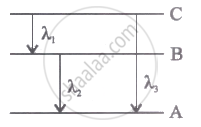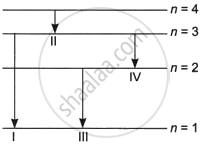Advertisements
Advertisements
प्रश्न
What are means by pair annihilation? Write a balanced equation for the same.
उत्तर
When a particle meets its antiparticle, the two annihilate to form a photon
`e^(-1) + e^(+1) -> "Photon(EMW)"`
APPEARS IN
संबंधित प्रश्न
A difference of 2.3 eV separates two energy levels in an atom. What is the frequency of radiation emitted when the atom makes a transition from the upper level to the lower level?
The total energy of an electron in the first excited state of the hydrogen atom is about −3.4 eV.
What is the kinetic energy of the electron in this state?
The total energy of an electron in the first excited state of the hydrogen atom is about −3.4 eV.
Which of the answers above would change if the choice of the zero of potential energy is changed?
Wavelengths of the first lines of the Lyman series, Paschen series and Balmer series, in hydrogen spectrum are denoted by `lambda_L, lambda_P and lambda_B` respectively. Arrange these wavelengths in increasing order.
Draw the energy level diagram showing how the line spectra corresponding to Paschen series occur due to transition between energy levels.
The energy levels of an atom are as shown below. Which of them will result in the transition of a photon of wavelength 275 nm?

Which transition corresponds to emission of radiation of maximum wavelength?
Energy levels A, B, C of acertain atom corresponding to increasing value of energy, i.e., EA< E8 < Ee. If λ1, λ2 and λ3 are the wavelength of radiations corresponding to the transitions C to B, B to A and C to A respectively, which of the following statements is correct?

Two H atoms in the ground state collide inelastically. The maximum amount by which their combined kinetic energy is reduced is ______.
The diagram shows the four energy levels of an electron in the Bohr model of the hydrogen atom. Identify the transition in which the emitted photon will have the highest energy.

